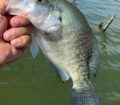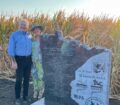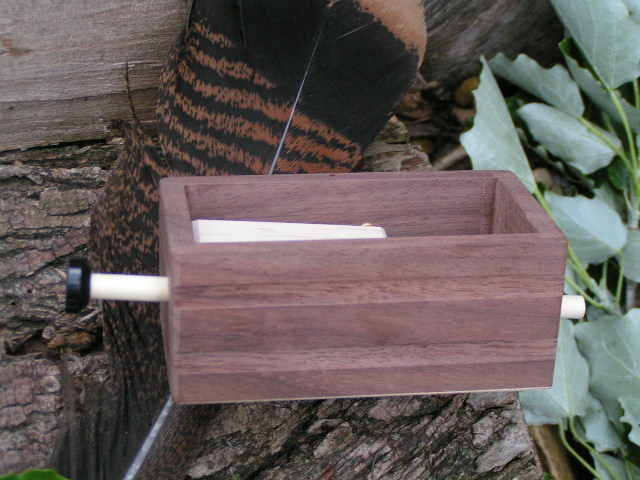By Steve Weisman
The 2023 August Roadside Count data is out, and pheasant hunters across the Hawkeye state received excellent news relating to this year’s pheasant season. The statewide survey showed the highest statewide counts since 2015. The survey is conducted by Iowa DNR staff between Aug. 1-15, as they drive 218, 30-mile routes on gravel roads at dawn on mornings with heavy dew.
The statewide average was 22.5 birds per route, which is an increase of 15 percent over 2022 (19.5 birds) and also 17 percent above the 10-year trend. According to Todd Bogenschutz, upland wildlife research biologist with the Iowa DNR, “The bird counts were better than we thought in northwest and northeastern Iowa. In the northeast that is the highest that region has seen in 24 years.”
Bogenschutz discussed the increase. “We haven’t had too many years since 2012 that areas were considered excellent, but there are some swaths of counties listed as excellent in northwest and north central Iowa – and over half of the state is considered fair to excellent.” With this in mind, Bogenschutz estimates around 400,000 birds will be bagged in 2023.
Unfortunately, the quail numbers did not follow the upward direction of pheasant and partridge. Counts in the southern Iowa’s quail belt will be similar to 2022. Still, Bogenschutz noted that quail hunting was pretty good last year and should be about the same this year in the southwest and south-central regions.
As for the partridge numbers took a big leap up. “The partridge population is up significantly with excellent counts coming from north central and northwest regions, and decent counts in parts of the east central region.”
Delving into the data
First, I’d like to thank the DNR personnel for their diligence in collecting the data. All of this data is then collected and turned over to Bogenschutz, and his staff, who then put a report together that gives a state-wide forecast, along with a closer look at nine different regions across the state. If you like to look at numbers and trends, the entire report is available at www.iowadnr.gov/pheasantsurvey.
This survey has been compiled since 1962, so with this year, we have 61 years of data to compare. There have been banner years, good years, fair years and down years! The formula for success and failure is pretty simple. Good upland habitat + favorable winter and spring weather = plentiful birds. Little upland habitat + unfavorable winter and spring weather = far fewer birds! Let’s look at the roadside count data by region.
Northwest (NW), Northcentral (NC) and Northeast (NE) results
As it has for the last several years, the NW region again leads the way with an average of 39.3 birds per route, which is up 26 percent from 2022 (31.2). It is also the highest number since 2015, when the count showed an average of 42.4 birds per route. Better counts in NW come from Clay, O’Brien, and Osceola counties with Dickinson, Emmet and Palo Alto counties also showing strong numbers. These counties all have ample public hunting areas and remaining CRP areas.
NC roadside counts show a 30.6 bird average, which is up 10 percent from 2022 (27.9). Floyd, Kossuth, and Winnebago counties reported better numbers in the NC region. NE roadside number took an incredible leap with a 26.9 bird average, which is an increase of 61 percent from 2022 (16.7). NE region reports the best counts in Bremer, Fayette, and Howard counties.
Westcentral WC), Central (C) and Eastcentral (EC)
The WC region data shows the highest counts in the central third of Iowa with 27.4 birds per route in 2023 even though it is a seven percent decline from 2022 (29.6). Greene, Guthrie, Sac and Woodbury counties hold the better numbers.
The C region at 26.4 birds/route, is up 17 percent from 2022 (22.6). Good bird numbers include Boone, Grundy, Hamilton, and Webster counties. Unfortunately, the EC numbers are only 10.1 per route, a 29 percent decrease from 2022 (14.2). Data shows that fewer hens and broods were sighted than in 2022. Better numbers appear in Benton, Johnson and Jones counties.
Southwest (SW), Southcentral (SC) and Southeast (SE)
The southern tiers remain extremely low for 2023. Even though the SW region shows an incredible 146 percent jump from the previous year, number-wise it still has low numbers at 12.7 birds per route in 2023 versus 5.2 in 2022. SC region shows 8.6 birds per route, a 17 percent increase from 2022 (7.4). SE region reports 13.7 birds per route a 4 percent increase from 2022 (13.1).
As a result, hunters should see better bird numbers across the southern regions. Some of the better counts in 2023 come from Adams, Cass, Jefferson, Keokuk, Louisa, Montgomery, Pottawattamie, Ringgold, Union, and Washington counties.
BOBWHITE QUAIL
Iowa’s statewide bobwhite quail index is unchanged from last year with 0.8 quail/route in 2023 compared to 0.9 quail/route in 2022. This year’s statewide quail index is -23% below the 10- year average and -42% below the long-term mean. Given the mild winter and lack of snowfall, quail numbers were expected to increase in 2023. According to Bogenschutz, this is a puzzling situation for the DNR. Anecdotal reports across the region showed good numbers of whistling males this past spring. Counts show no statistically significant trend in any of the southern regions. The SC region reports the best overall county numbers in 2023, followed by the SW region. Better counts come from Adams, Madison, Taylor, Union and Wayne counties.
Gray Partridge
The statewide gray partridge count increased by 43 percent compared to 2022 numbers. This is 13 percent above the 10-year mean, but unfortunately it is still 32 percent below the long-term mean. Partridge are found in the northern and central regions of the Hawkeye state, and the counts show increases in all regions but the NE region. Typically, partridge numbers increase following mild winters and when spring/summer precipitation is below normal. Better counts in 2023 come from Boone, Buena Vista, Cerro Gordo, Emmet, Franklin, Hamilton, Palo Alto, Pocahontas, Sac and Wright counties.
Cottontail rabbit
DNR staff report an average of 4.73 rabbits per 30-mile route in 2023, which represents no change from the 2022 estimate. Cottontails remain very abundant in Iowa. However, the cottontail index is 18 percent below the 10-year average and 21 percent below the long-term average, respectively. Counts show the best numbers in the SC region with upward trends in the WC, EC, and SW regions, downward trends in NW and C regions and no trend in the remaining regions. Cottontails typically increase following mild winters with good moisture during spring and summer. Thus, the drought of 2023 likely has impacted reproduction in many regions. According to Bogenschutz, cottontail hunters can expect good hunting across most of the state this fall. Staff report the best cottontail numbers in the SC region with good numbers also reported in the WC, EC, SW, and SE regions.
Where to hunt
First, there are the 410,000 acres of public land managed by the Iowa DNR’s Wildlife Bureau. You can go to the Iowa DNR website and see the public hunting areas by county. There is also a Hunting Atlas, interactive map of Iowa’s public hunting lands. In 2022, hunting on public areas in northwest Iowa was some of the best in recent years. The same should hold true in 2023.
A second opportunity is the DNR’s walk-in hunting program, Iowa Habitat and Access Program (IHAP), is funded through a combination of the Farm Bill and DNR license dollars. Most IHAP sites are typically private CRP lands where the DNR has provided incentives to landowners to manage habitat for wildlife in exchange for public hunting access. Iowa DNR has more than 32,000 acres in this program. For a list of IHAP sites or information about enrolling, visit http://www.iowadnr.gov/ihap.
Finally, there is private land, where permission is needed for the general public to access and hunt. The best private areas are lands that are in the Conservation Reserve Program (CRP), a program which has been extremely important for upland habitat over its 37-year history. As of September 2022, 1,69 3,946 acres were enrolled across the state of Iowa, which is the lowest in program history. CRP acres peaked in 1994 with 2,203,794 acres. It will be interesting to see how the new Farm Program will handle future CRP opportunities.
One last look
With corn and bean fields maturing rapidly, there is a good chance that most of the crops will be out of the field by the October 28 opener. With that cover gone, the birds will turn to the grass and prairie areas, which should tip the odds in the direction of pheasant hunters.
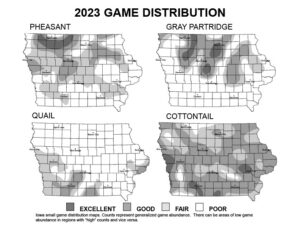
Courtesy Iowa DNR Roadside Count collection
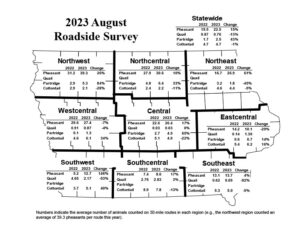
Courtesy Iowa DNR Roadside Count collection
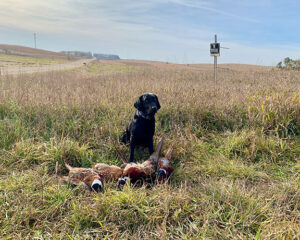
(photo by Steve Weisman) The 2022 pheasant opener was extremely successful in northwest Iowa, and projections are for an even better opener in 2023.

